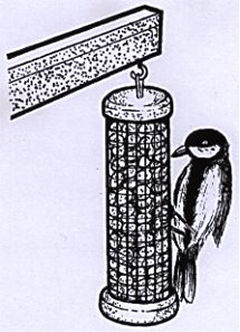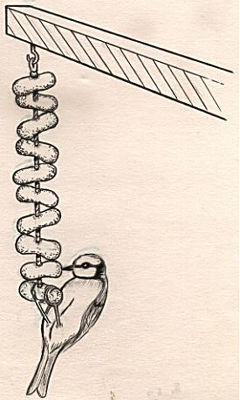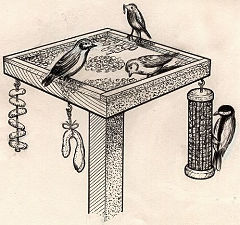Factsheet
Feeding Garden Birds
Birds appreciate being fed throughout the year, but winter is their most difficult time, when they find it hard to find their natural food, such as insects, worms, berries and seeds.
When to Feed Birds
 Birds appreciate being fed throughout the year, Winter and early spring is the most important time to feed birds, as this is when their natural food is scarce. Feeding birds in the spring and summer may help them to raise their chicks more successfully. Luckily, most birds take readily to a variety of food items that we can easily provide and this helps them to survive the cold winter months.
Birds appreciate being fed throughout the year, Winter and early spring is the most important time to feed birds, as this is when their natural food is scarce. Feeding birds in the spring and summer may help them to raise their chicks more successfully. Luckily, most birds take readily to a variety of food items that we can easily provide and this helps them to survive the cold winter months.
Seed-eaters, such as chaffinches and greenfinches enjoy being offered a supply of seeds all through the year. Birds, whether they are insect or seed eaters when adult, feed their babies on insects and other minibeasts; it is not a good idea to put out loose whole peanuts in the spring and summer - a whole peanut fed to a baby bird by a misguided parent may choke it! However, most other types of food can be quite safely offered throughout the year.
As well as helping the birds, feeding them enables us to watch them close-up, observe their behaviour and even photograph them quite easily!
Suitable Food for Garden Birds
Almost any kitchen leftovers can be used. Here are the most useful types of food:-
Bread:
wholemeal bread is best as long as it is crumbled up and moist. Soak very dry bread before offering it to the birds.
Cooked rice, pasta, pastry & potatoes:
these have lots of starch and are appreciated by a variety of birds.
Stale cake & biscuits:
in addition to starch, these contain fat which is an excellent source of energy.
Cheese:
wrens and robins love crumbled or grated cheese.
Fat:
bacon rind, fat trimmed from chops and suet may be cut up into small bits or it can be hung up in a lump.
 Fruit:
Fruit:
windfalls or bruisedapples and pears are loved by blackbirds and thrushes. Winter visitors such as redwings and fieldfares, from Scandinavia, may be attracted too. Dried fruits e.g. raisins and sultanas, are appreciated too but always soak these first.
Peanuts:
these are rich in fat and attract a host of birds, including the titfamily, greenfinches, house sparrows, nuthatches, siskins and great spotted woodpeckers. Shelled peanuts may be put in wire mesh containers and hung up. Crushed or chopped nuts may be put out for robins and dunnocks (hedge sparrows). A chain of peanuts in their shells can be made by threading them onto string with a darning needle. Never use salted nuts - these cause the birds to dehydrate.
Fresh Coconut:
this is a favourite with tits. First drain off the milk from a whole coconut by drilling two holes in one end, then saw it in half and hang outside. Never give dessicated (dried) coconut to birds as this swells up inside a bird's stomach.
Bird Seed:
most pet shops and garden centres sell specially prepared seed mixes for wild birds. Greenfinches and chaffinches prefer sunflower seeds, whereas dunnocks and other finches prefer smaller seeds, such as canary seed and millet.
For more information see RSPBs page of advice.
Remember...do not feed the following to your garden birds:- salted nuts, dessicated coconut, highly-spiced food, white bread or very dry bread.
Where to put the food
 Bird Table: a bird table is a convenient place to put out food. It doesn't have to be an elaborate structure - just a 40cm square of exterior grade plywood, preferably with a ridge around the edges, screwed onto a 1.7m post (sunk about 40cm into the ground) is sufficient. It is important to place the table in the right spot. You will want to watch and study the birds, so it needs to be not too far from the house, perhaps, for example, a few feet from the kitchen window.
Bird Table: a bird table is a convenient place to put out food. It doesn't have to be an elaborate structure - just a 40cm square of exterior grade plywood, preferably with a ridge around the edges, screwed onto a 1.7m post (sunk about 40cm into the ground) is sufficient. It is important to place the table in the right spot. You will want to watch and study the birds, so it needs to be not too far from the house, perhaps, for example, a few feet from the kitchen window.
Cats can be a real nuisance, so bushes and trees should be more than a leap away from the table - a minimum of 2 metres. An inverted metal cone or biscuit tin around the post of a birdtable will make it difficult for cats to climb up (it may also stop squirrels climbing up too!). Instead of being fixed to a post, a table could also be fixed to a wall or a window-sill.
OTHER PLACES; some garden birds are reluctant to feed several feet above the ground. Dunnocks and wrens, for example, prefer to scratch around on the ground, so scatter food for them on the open ground around the bird table. Nuts, fat and coconuts can be hung either from the table or from branches of trees.
Remember:
(i) once you begin putting out food, birds will be attracted from quite a wide area and they will come to rely on you; if you suddenly stop feeding, some of these birds may die, unable to find enough food to survive.
(ii) put food out at regular times - first thing in the morning is probably the best time so that there is a supply of food ready for the hungry birds emerging from a cold night.
(iii) don't overfeed and leave uneaten food lying around during the night. Accumalation of stale food can cause health problems for the birds and attract rats and mice.
Water
Birds need water to drink and bathe in. They must be able to keep their feathers clean in order to keep warm in severe weather. A shallow-edged pond is an ideal watering place for birds, but an upturned dustbin lid or flowerpot base will do just as well. Sink the container into the ground or raise it up on bricks to stop it wobbling about. Keep the water clean and fresh to avoid disease. In very cold weather, keep the bath clear of ice. If the bath is made of metal or stone, a night-light underneath stops ice forming. Do not put antifreeze or salt in the water!
Recipe For Bird Cake
First make a mould from something suitable. A half-coconut shell with string or wire threaded through a small hole in the base makes a good one. Alternatively, an old yoghurt pot can be used (see below).
Ingredients:
500g fat (suet is best)
500g mixed bird seed (not too many large seeds)
750g (up to this but no more) scraps e.g. cake & biscuit crumbs, grated cheese, minced peanuts, sultanas, brown bread etc.
Method:
1. Carefully melt the fat in a large saucepan - don't make it too hot.
2. Stir all the rest of the ingredients into the fat.
3. Pour the mixture into the mould and leave to cool and set. If using a yoghurt pot, push a length of wire into the mixture while it is still soft.
4. When the cake is set, hang the coconut mould upside down in the garden. Cake made in a yoghurt pot can be carefully scooped out using a knife, and hung up by the wire.
Gardening for Birds
 Apart from putting out special food for birds, there are several other ways in which we can attract even more bird species to our gardens. Here are a few ideas:-
Apart from putting out special food for birds, there are several other ways in which we can attract even more bird species to our gardens. Here are a few ideas:-
Grow shrubs which have berries and fruit e.g. elder, hawthorn, cotoneaster, pyracantha, honeysuckle, ivy and mahonia. These plants may also provide nesting sites.
Birds prefer untidy gardeners. Leave dead heads on plants so that the birds can pick out the seeds. Don't clear up all the autumn leaves - leave some leaf litter around so that birds can scratch around in it for minibeasts.
Don't use pesticides. Leave the aphids on the roses for the blue tits to enjoy - don't spray them with chemicals. Pellets used for killing slugs and snails can be dangerous to birds and other wildlife; if a thrush eats a poisoned slug, it may itself be affected by the poison. If you have thrushes around, they will help to control the slug and snail population in your garden, so there should be no need to resort to chemicals.
Credits
Image: Feeding Garden Birds by Roy
 Birds appreciate being fed throughout the year, Winter and early spring is the most important time to feed birds, as this is when their natural food is scarce. Feeding birds in the spring and summer may help them to raise their chicks more successfully. Luckily, most birds take readily to a variety of food items that we can easily provide and this helps them to survive the cold winter months.
Birds appreciate being fed throughout the year, Winter and early spring is the most important time to feed birds, as this is when their natural food is scarce. Feeding birds in the spring and summer may help them to raise their chicks more successfully. Luckily, most birds take readily to a variety of food items that we can easily provide and this helps them to survive the cold winter months. 
 Fruit:
Fruit: Bird Table: a bird table is a convenient place to put out food. It doesn't have to be an elaborate structure - just a 40cm square of exterior grade plywood, preferably with a ridge around the edges, screwed onto a 1.7m post (sunk about 40cm into the ground) is sufficient. It is important to place the table in the right spot. You will want to watch and study the birds, so it needs to be not too far from the house, perhaps, for example, a few feet from the kitchen window.
Bird Table: a bird table is a convenient place to put out food. It doesn't have to be an elaborate structure - just a 40cm square of exterior grade plywood, preferably with a ridge around the edges, screwed onto a 1.7m post (sunk about 40cm into the ground) is sufficient. It is important to place the table in the right spot. You will want to watch and study the birds, so it needs to be not too far from the house, perhaps, for example, a few feet from the kitchen window. Apart from putting out special food for birds, there are several other ways in which we can attract even more bird species to our gardens. Here are a few ideas:-
Apart from putting out special food for birds, there are several other ways in which we can attract even more bird species to our gardens. Here are a few ideas:-